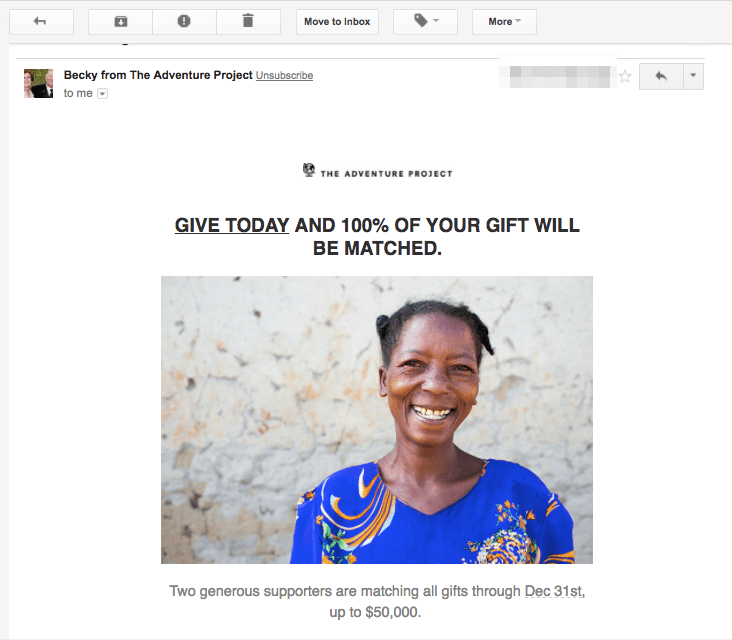It’s the end of the year, which means it’s time to send some year-end fundraising emails! Or else it’s time to look blankly at the page while you try to plan your year-end fundraising email campaign because you’re not sure how many emails is too many or what your emails should include.
Deep breaths. If that’s you, we’ve got just what you need: a practical list of the types of emails that are great for year end, suggested timelines, and a template for building your own year-end email fundraising campaign. Ready? Let’s dive in!
General Principles
In our experience, it’s a good idea to send at least five emails during your year-end campaign to ensure your message makes it out to donors- remember, not everyone is going to see every email you send. These emails should coincide with your wider, multi-channel year-end campaign promotion timeline.
We’ll get into more detail about the types of emails you can send, but all of them should include some story-driven content. Think about what will get your donors emotionally invested in your work, and then showing them how they can make a difference.
Here are the elements that should be included in all of your emails:
- A strong subject line that stands out in the inbox. It might include an emoji, fun wordplay, or a question.
- A clear statement of your fundraising goal and impact
- A clear call to action, whether it’s a donate button or another action you would like readers to take.
Let’s look more carefully at each kind of email in turn.
Email Types
1. The Pre-Year-End Fundraising Thank You Email – Sent Before or Around Thanksgiving

Before you properly launch your year-end fundraising campaign, it’s a good idea to send an email that’s not asking for anything. Simply thank your donors and let them know you’re thinking of them. We even have 14 ideas of how you can thank your donors at Thanksgiving. Here’s what this email should include:
- A thank you message
- An update on what you’ve been doing
- Pictures or graphics to tell your story
This is an ideal email to send right around Thanksgiving to fit in thematically.
2. The Soft Launch Email – Sent 1-2 Weeks Before General Campaign Launch
The soft launch is a chance to introduce your campaign to hand-picked supporters before you push it out to larger networks. If you’re planning on doing a soft launch, putting together a strong email to introduce your campaign to supporters is integral.
Here’s what the email should include:
- A description of your campaign and goals
- A clear ask of your supporters, whether that’s setting up a peer-to-peer fundraising page or writing a love letter to a theater
- A deadline for the action
- Language that shows these supporters they’re special and have been hand-picked
This email can go out around the same time that your thank you email goes, or even a bit before. It will depend on what you want your supporters to do and how much time you think they’ll need, but in general leave two weeks between your main launch and your soft launch.
3. The Year-End Fundraising Launch Email – Between Thanksgiving and GivingTuesday OR The First Week Of December
Ok, you’ve set up your donors with a thank you email and run your soft launch. Now it’s time to introduce the world to your year end campaign. Here’s what belongs in this email:
- A subject line (with emoji) to stand out in the inbox
- Strong branding that will continue throughout the campaign. This might be a logo, specific fonts and colors, or an email design that will hold through the upcoming emails.
- A story that will tug at heartstrings
- Your goal for the campaign and a clear impact statement
- A clear CTA in the form of a question, plus a donate button
Ideally this email can drop between Thanksgiving and GivingTuesday. You’ll pick up on these same themes in your GivingTuesday email.
4. The GivingTuesday Fundraising Email – On GivingTuesday (Nov 28)
It’s a good idea to send something on GivingTuesday, even if you’re not planning a full campaign. It’s even better if you can seamlessly blend GivingTuesday and your year-end campaign. In some cases, you may want to use your GivingTuesday email as the launch of your year-end campaign. It’s up to you!
Here’s what to include:
- Your goals for the day
- A matching grant if you can get one
- Hashtags and social media info to encourage your donors to share
- A donate button
- A specific ask: what is your focus for GivingTuesday? Is there one element of your work that you can focus on?
Obviously this email should head out on GivingTuesday.
Plan for GivingTuesday and Year-End with this free resource package!
5. The 2nd Year-End Fundraising Email – Sent ~ A Week or Less After GivingTuesday

Now your donors know what’s up and it’s your job to keep reminding them that there’s time to donate. Your second year-end fundraising email can dive deeper into a story or program. Your donors know the overview of the campaign. Now it’s time to sell them on it. Here’s what to include:
- More information about how your programs make an impact
- A personal story from yourself, a client, or a supporter
- Images that support the story
- Any strong statistics of your impact or the need you address
- A call to action to donate a specific amount
This email can go out a few days to a week after GivingTuesday.
6. The 3rd Year-End Fundraising Email – Sent 2nd-3rd Week of December
This is your last general campaign email, and another chance to tell more of your story. Here’s what you can do to make it stand out:
- Use a subject line with your numbers so far, or another statistic that grabs attention
- Give your supporters an update on the progress you’ve made so far
- Share another story, or build on the one you shared in the last email
- A call to action that tells donors what their donation would do (in the example email above, “Keep them warm” is a great example)
This email can go out the second week in December.
7. The Time Is Running Out Email
Now it’s time to start instilling urgency into your campaign. You’re over halfway through December and donors need to take an action now.
- Use FOMO in your subject line: make it clear that they’ll miss out if they don’t act now
- Share how many days are left for donors to make their tax deductible donation
- Share some information about what you’ve accomplished this year and/or what you hope to accomplish in the upcoming year
- This is a good opportunity to use the theme of the holidays and generosity
This email should go out between Dec 20th-Dec 27th to drive urgent gifts before the end of the year.
8. The December 31st Email – Sent On December 31

This is your last ask of the year and you want to make the most of it!
- Emphasize that it’s the last chance to donate
- Share how your donors impact will be doubled (if that is something you have been able to arrange).
- This is a good time to be light-hearted: people tend to be in a positive mood, thinking about new beginnings and goals, and optimistic as they head into the new year. Play on those themes.
- Share how close you are to your goal. It can be motivating if you share that each person who gets the email only needs to donate $10 (as an example) for you to reach your goal.
- Thank everyone who has donated so far for their support.
9. The Follow Up Thank You Email – Sent The First Week Of January
After the year is over you don’t want to ghost your supporters. In the first week of January make sure that you send a thank you/follow up email to let them know how your campaign went. Include:
- A big thank you!
- Information on how your campaign went, especially if you reached your goal. It’s good to celebrate together.
- A note about the impact that you made: what did your campaign accomplish?
- A call to action that doesn’t involve making a donation: follow on social media, check out our website, or something similar.
Sample Campaign Plan
If you’re wondering how this all comes together, here’s an example of what your communications schedule might look like:
Nov. 21: Thank you email with Thanksgiving theme
Nov. 27: Soft launch campaign email to invite board members to fundraise
Nov. 28: GivingTuesday email focusing on a matching grant
Dec. 5: Campaign launch email with details about your goal and impact
Dec 10: Campaign email #2 with a client story
Dec. 17: Campaign email #3 with updates on how you’re doing so far
Dec. 27: ‘3 days left’ email focused on what’s left to be done
Dec. 31: Last chance email with powerful stats about what you did in 2023
January 4: Thank you and follow up email letting supporters know how the campaign went
When you set up an email campaign like this you get a few benefits. First, you’ve got a clear plan so that you don’t spend your last few months scrambling to get donations and feeling panicked. But even more importantly, a carefully structured email campaign will increase your year-end fundraising.

A final note to keep in mind: you could write the best emails in the world, but if the donation process is difficult or the content on your page just isn’t up to standard, you’ll miss out on donations.
To get the best results, you’ll want to create an online, branded year-end fundraising campaign with a live progress bar and more content, and a page that drives donor conversion. Bonus tip: keep in mind many people check emails on their phone, so it needs to be mobile optimized.
Don’t forget to make sure that your email plan falls in line with your larger year-end strategies.
Download our Free 2023 Year-End & Giving Fundraising Toolkit:
Ready To Get Your Fundraising Campaign Started?
Are you ready to start preparing your year-end fundraising campaign? CauseVox has tools that make it all easy, You can drive all your supporters to one page for donations, ticketing and peer to peer, and use beautiful donation forms for one-time, monthly recurring and pledge donations.
Raise more with less effort. Easy for you to set up and easy for your donors to navigate.
Book a demo to learn how CauseVox can power your Year-End Fundraising.
Editor’s Note: This post was updated in October 2023 for relevance.
Editor's Picks
Ultimate Guide To Peer-to-Peer Fundraising
Customer Story: Spur Local Raises Over $1M With Their Give Local Campaign
Fundraising Strategies for Nonprofits: Craft the Best Approach for Your Organization
Create a Killer Fundraising Plan - Best Practices, Strategies, & Downloadable Template



